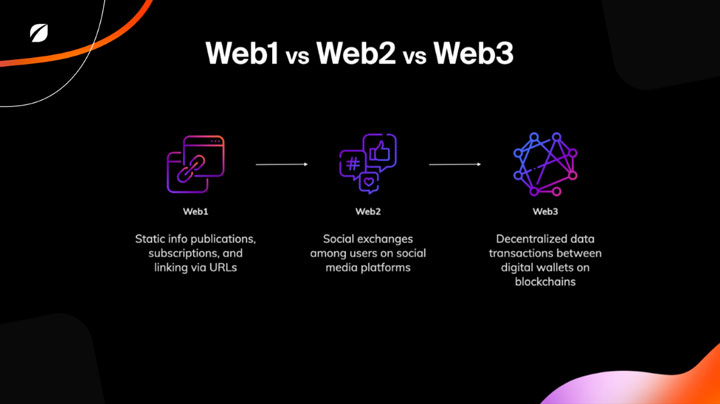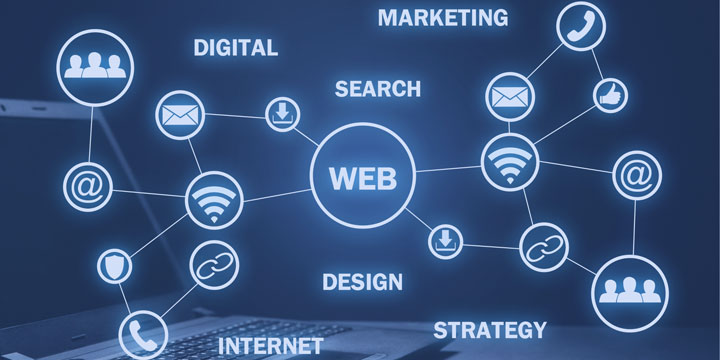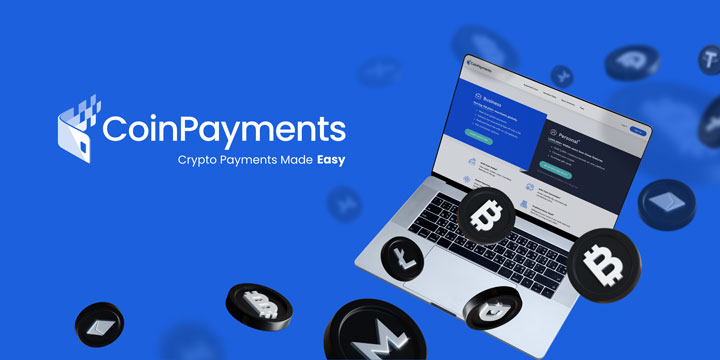Join us as we unravel the evolution of the internet, starting with history, then a comparison of Web3 vs Web2, and a glimpse into the future of decentralized networks, smart contracts, and more. Let’s dive in!
The internet has come a long way since dial-up connections and static websites. We’ve moved from the simplicity of Web1 to the social connectivity of Web 2.0. Now we stand on the brink of another transformative era: Web 3.0.
Web 2.0, the internet as we know it today, has seen exponential growth, but it’s not without its challenges. Governed by central authorities, it’s a world where personal data often falls into the hands of internet giants. Web 3.0, on the other hand, promises a decentralized structure, giving users more control and agency over their digital lives. It’s a vision centered around blockchain technology, providing transparency, security, and a new way to interact online.
In this article, we’ll explore the journey from Web1 to Web3, highlighting the key differences between Web3 vs Web2. We’ll delve into these internet generations’ core features, benefits, and challenges and look at how Web3 can improve our lives and work in the digital world.
History of the Web

Source: Freshconsulting
The history of the World Wide Web is a tale of innovation, collaboration, and exponential growth. It’s a journey that has transformed how we access data, interact online, and connect with the world.
In the early days, the internet was a read-only web, filled with static websites. Users could view content, but user interaction was minimal. It was a time when web browsers were simple tools for accessing information, and the internet was primarily a place to read rather than create (Web1).
As technology advanced, the internet began to evolve. The emergence of social media platforms and the ability to create user-generated content marked a significant shift. The web became a place for social connectivity, where internet users could share, comment, and engage with each other (Web2).
Today, we stand at the threshold of a new era. The concept of decentralized networks is gaining traction, paving the way for Web3. This third generation aims to give users greater control over their digital assets, data ownership, and online transactions. It’s a shift towards a decentralized structure, where power is distributed, and central authority is minimized (Web3).
The Role of Blockchain Technology?
At the heart of this transformation is blockchain technology. It’s the foundation for decentralized apps, smart contracts, and finance. Blockchain offers transparency, security, and a way to bring users into a world where they have complete control over their digital lives.
Web2 – The Social Web

Web2, the term coined to describe the second generation of the internet, marked a revolutionary shift in how we interact online. Emerging in the early 2000s, Web2 transformed static websites into dynamic, interactive platforms, reshaping the way we communicate, share information, and conduct business.
What is Web2?
Web2 is characterized by its focus on user interaction, social connectivity, and a more engaging user experience. It’s a world where web users can consume content, contribute, collaborate, and connect. From social media platforms to e-commerce, Web2 has profoundly impacted the digital world.
Here’s what sets Web2 apart:
- Interactive Websites: Unlike the read-only web of the past, Web2 brought life to websites, making them more interactive and user-friendly. Features such as forms, forums, and social media integration became commonplace.
- Social Media Revolution: Platforms like Facebook, Twitter, and LinkedIn emerged, revolutionizing how we communicate and share online. Social media became a central part of our digital lives.
- E-commerce Growth: Businesses and consumers found a new way to connect through e-commerce platforms like Amazon and eBay. Buying and selling goods and services online became easier and more accessible.
Features of Web2
Web2’s core features fostered online interaction and connectivity, giving rise to a new era of digital applications. Here’s a closer look:
Classification of Information
Web2 made information retrieval and classification simpler. Users could easily sort and access data, enhancing the overall experience.
Better User Experience
Technologies like Ajax and HTML5 replaced traditional modes like Flash, creating dynamic and interactive web pages. Web2 prioritized user experience, making browsing more enjoyable.
User-Generated Content
Web2’s emphasis on user interaction allowed for creating and contributing user-generated content. Users could add reviews, comments, and even their content to websites. Platforms like YouTube and Vimeo exemplify this shift, providing spaces for creativity and collaboration where users can share their unique web addresses, videos, and more.
The impact of Web2 on the internet and society is undeniable. It’s a chapter in the history of the web that redefined our online interactions and set the stage for the next evolution: Web3.
Web3 – The Decentralized Web

Web3, often called the “Semantic Web,” represents the next evolutionary step in the world wide web’s journey. Unlike the centralized systems of Web 2.0, Web 3.0 emphasizes decentralization, security, and user control. It’s a paradigm shift reshaping how we interact with the digital world.
What is Web3?
Web3 is a decentralized network that leverages blockchain technology to create a more transparent and secure internet. It’s a world where users have greater control over their data, and central authority is replaced by decentralized data networks. Here’s a closer look at what sets Web3 apart:
- Blockchain Technology: At the core of Web3 is blockchain technology, providing a decentralized structure for data storage and transactions. This technology ensures transparency and security, moving away from single server control to multiple locations.
- Decentralized Applications (dApps): Web3 fosters the development of decentralized apps (dApps), which operate without a central governing body. These applications run on peer-to-peer networks, allowing for more control and flexibility.
- Internet of Things (IoT): Web3’s decentralized network enables seamless integration with IoT devices. This connectivity promises exponential growth in automation and efficiency across various industries.
- Data Ownership: In the Web3 era, users interact with the internet with complete control over their data. Unlike the centralized servers of Web2, Web3 ensures data ownership, allowing users to manage and even monetize their information.
Features of Web3
Semantic Web
Web 3.0 enhances user experience through the semantic web, allowing computers to understand and process data more meaningfully. This feature brings about a more personalized and connected internet experience.
Decentralization
Decentralization is a core feature of Web3, distributing ownership and governance among users. This shift from centralized systems to decentralized data networks empowers users and reduces reliance on internet giants.
Universality
Building on the success of Web2, Web3 aims to make the Internet accessible to everyone. With the integration of new smart devices and technologies, Web3 is expanding the reach of the internet beyond traditional platforms.
Trustless and Permissionless Systems
Web3 operates on a trustless network, eliminating the need for third-party verification. It’s a permissionless system where users can interact without authorization from a governing body, fostering a more open and accessible digital world.
Decentralized Finance (DeFi)
Web3’s decentralized structure supports the growth of decentralized finance, allowing for more transparent and accessible financial transactions through smart contracts and digital currencies.
Web3’s decentralized web is more than just a technological advancement; it’s a vision for a more equitable and user-centric internet. As we continue to explore the key differences between Web2 and Web3, the potential impact of Web3 on our digital lives becomes increasingly apparent. It’s a future that promises greater control, security, and innovation, aligning with the internet’s original promise of connectivity and freedom.
Further Reading: Crypto and Web3: What’s the Connection?
Comparing Web3 vs Web2

Source: The Guardian
The evolution from Web2 to Web3 marks a significant shift in how we interact with the Internet. While both have unique strengths and weaknesses, their profound differences impact various aspects of online interaction. Let’s delve into a comparative analysis of Web2 and Web3:
Technological Framework
Web2: Utilizes layout technologies like CSS and Ajax to create dynamic products and services running on relational databases.
Web3: Builds on common layout technologies but integrates blockchain platforms like Ethereum or Solana to run products and services.
Governance Structure
Web2: Governed by centralized authorities, applications, cloud services, and platforms are managed by specific corporations or entities.
Web3: Emphasizes decentralized governance, managing products and services through peer-to-peer networks and distributed consensus.
Censorship and Control
Web2: Bound by jurisdictional laws, centralized corporations enforce strict censorship regulations, leading to frequent deplatforming.
Web3: With its decentralized nature, censorship becomes less applicable, fostering a more open and freer internet environment.
Ownership and User Sovereignty
Web2: Platforms leverage personal data, activity, and content to generate profit, often without directly benefiting the user.
Web3: Users own their personal data, activity, and content, empowering them to control and potentially profit from their online presence.
Privacy and Security Measures
Web2: Requires personal data for access, leading to privacy concerns. Centralized systems can provide support in case of breaches.
Web3: Enhances privacy by not requiring personal data but lacks a centralized authority to turn to if a decentralized application or non-custodial wallet is hacked.
Payment and Transaction Methods
Web2: Relies on government-issued fiat currencies like $USD, settling transactions through centralized banks.
Web3: Utilizes cryptocurrencies such as Ether, USDC, and Solana, enabling anonymous and open payments and transactions.
The Growing Pains of Web3
The transition from Web2 to Web3 is filled with promise but not without challenges. The very features that make Web3 appealing, such as decentralization and openness, also present unique obstacles that must be overcome. Let’s explore some of the growing pains associated with the rise of Web3:
Content Regulation and Legal Complexity
Web3’s decentralized nature makes it difficult to filter out harmful content such as cybercrime, hate speech, and misinformation. Unlike Web2, where centralized authorities can enforce regulations, Web3’s distributed structure complicates matters. Determining which country’s laws apply to a website hosting content in multiple nations becomes a complex legal puzzle, posing challenges for regulation and enforcement.
Slower Transactions and Increased Costs
The peer-to-peer (P2P) network that underpins Web3 means that every transaction must be processed through the entire network. This requires substantial computing power, potentially slowing down the instantaneous transactions we’ve grown accustomed to in the Web2 era. Furthermore, the energy-intensive nature of these transactions may lead to the introduction of “gas fees” for currently free activities, such as creating an NFT.
Technological Limitations
Integration with existing web browsers and the need for significant advancements in computing power present further hurdles. Industry experts, including tech giants like Intel, estimate that achieving Web3’s full potential requires a thousand-fold increase in our computing capabilities. This highlights a gap where software innovation has outpaced hardware development, creating a technological bottleneck.
Skepticism and Competing Visions
While many view Web3’s early stage as ripe with opportunity, others are more skeptical. Doubts about blockchain technology’s ability to deliver on its promises exist, and competing platforms are emerging. Tim Berners-Lee, one of the pioneers of the internet, has even launched a competing platform called Solid, built on standard web tools and principles he defines for Web 3.0.
Peeking into the Future: What’s Next for the Web?
The emergence of Web3 heralds a new era of decentralization, promising a more user-centric and equitable online experience. With the potential for seamless interaction between blockchain networks and the rise of decentralized applications, the future is ripe with innovation. However, challenges in complexity, user experience, regulation, and security must be thoughtfully addressed.
The path to Web3 is an exciting journey, likely to see an integration with Web2, rather than a complete replacement.
As we stand on the brink of this technological evolution, the future of the web is a thrilling mystery, filled with endless possibilities. The next chapter of the internet is being written; we are all part of this unfolding story.
Join the Web3 Revolution with CoinPayments

As we stand on the brink of a new era in internet technology, CoinPayments offers you a gateway to embrace the decentralized, user-centric future that Web3 promises. Whether you’re an individual exploring the world of cryptocurrencies or a business ready to take the next step in digital transactions, CoinPayments provides the tools and security you need.
Explore CoinPayments and Be Part of the Future!





